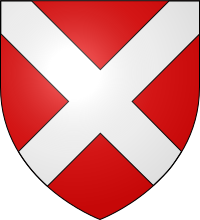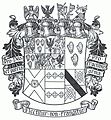Earl of Westmorland
| Earldom of Westmorland | |
|---|---|
heirs male of the body lawfully begotten | |
| Subsidiary titles | Baron Burghersh |
| Extinction date | 1571 (first creation) |
| Former seat(s) | Raby Castle (now seat of the Barons Barnard) Apethorpe Palace Mereworth Castle |
| Motto | Ne Vile Fano ("Disgrace not the altar"; Fane) Ne vile velis ("Form no mean wish"; Neville) |
Earl of Westmorland is a title that has been created twice in the
1397 creation

Westmorland married as his second wife
Thenceforward Westmorland was busily engaged in negotiating with the Scots and keeping the peace on the borders. He did not play the part assigned to him by Shakespeare in Henry V., for during Henry's absence he remained in charge of the north, and was a member of Bedford's council. He consolidated the strength of his family through marriage alliances. His daughter Catherine married in 1412
Ralph Neville, 2nd Earl of Westmorland (c. 1404–1484), the son of John, Lord Neville (died 1423), succeeded his grandfather in 1425, and married as his first wife Elizabeth Percy, dowager Baroness Clifford, the daughter of Sir Henry "Hotspur" Percy, thus forming further bonds with the Percies. The 3rd Earl, Ralph Neville (1456–1499), was his nephew, and the son of John Neville, Lord Neville, who was slain at the Battle of Towton. His grandson Ralph Neville, 4th Earl of Westmorland (1499–1550), was an energetic border warrior, who remained faithful to the royal cause when the other great northern lords joined the Pilgrimage of Grace. He was succeeded by his son Henry, 5th Earl (c. 1525–1563).[3]
During the reign of James I, the earldom was claimed by Edward Neville, a descendant of

He died about 1640. "There was issue male existing long after the 17th century from the 1st Lord Latimer of this creation. That from Thomas Nevill, of Pigotts Ardley, co. Essex (who d. 1550 and who was next yr. br. to William Nevill abovenamed and to John, the 3d Lord Latimer), ancestor of the Nevills, of Halstead, in that county, is said to have existed for eight generations in Drummond's "Noble British Families"" [6] See also[7]
1624 creation

The title was revived in 1624 in favour of Sir Francis Fane, whose mother, Mary Neville, was a descendant of a younger son of the first Earl of the 1397 creation. He was created Baron Burghersh, in the County of Sussex, and Earl of Westmorland in the Peerage of England 1624, and became Baron le Despencer on his mother's death in 1626. His son Mildmay Fane, 2nd Earl of Westmorland, at first sided with the king's party in the English Civil War, but was afterwards reconciled with the parliament. John Fane, 7th Earl of Westmorland, served under the Duke of Marlborough, and was made in 1739 lieutenant-general of the British Armies.[4]
His published works include Memoirs of the Early Campaigns of the Duke of Wellington in Portugal and Spain (1820), and Memoir of the Operations of the Allied Armies under Prince Schwarzenberg and Marshal Blucher (1822).[4]
Earls of Westmorland; First creation (1397)

- Ralph Neville, 1st Earl of Westmorland (c. 1364–1425)
- Ralph Neville, 2nd Earl of Westmorland (1408–1484)
- Ralph Neville, 3rd Earl of Westmorland (1456–1499)
- Ralph Neville, 4th Earl of Westmorland (1497–1549)
- Henry Neville, 5th Earl of Westmorland (1525–1564)
- Charles Neville, 6th Earl of Westmorland (1542–1601) (forfeit 1571)
Earls of Westmorland; Second creation (1624)

- Francis Fane, 1st Earl of Westmorland (1580–1629)
- Mildmay Fane, 2nd Earl of Westmorland (1602–1666)
- Charles Fane, 3rd Earl of Westmorland (1635–1691)
- Vere Fane, 4th Earl of Westmorland (1645–1693)
- John Fane (1676–1678)
- Vere Fane, 5th Earl of Westmorland (1678–1699)
- Thomas Fane, 6th Earl of Westmorland (1683–1736)
- John Fane, 7th Earl of Westmorland (1685–1762)
- Thomas Fane, 8th Earl of Westmorland (1701–1771)
- John Fane, 9th Earl of Westmorland (1728–1774)
- John Fane, 10th Earl of Westmorland (1759–1841)
- John Fane, 11th Earl of Westmorland (1784–1859)
- John Arthur Fane (1816–1816)
- George Augustus Frederick John Fane, Lord Burghersh (1819–1848)
- Ernest Fitzroy Neville Fane, Lord Burghersh (1824–1851)
- Francis William Henry Fane, 12th Earl of Westmorland (1825–1891)
- George Neville John Fane, Lord Burghersh (1858–1860)
- Anthony Mildmay Julian Fane, 13th Earl of Westmorland (1859–1922)
- Vere Anthony Francis Fane, 14th Earl of Westmorland (1893–1948)
- David Anthony Thomas Fane, 15th Earl of Westmorland (1924–1993)
- Anthony David Francis Henry Fane, 16th Earl of Westmorland (born 1951)
The heir presumptive is the present holder's nephew, Sam Michael David Fane (born 1989).
See also
- Baron Latymer
- Viscount Fane and Fane de Salis
- Baron Barnard
Gallery
-
Fane De Salis Coat of arms
-
Mildmay Fane (1689-1715) by Alexis-Simon Belle
-
Portrait by Joshua Reynolds of John Fane 9th Earl, 1764.
-
Portrait by Thomas Lawrence of John Fane 10th Earl, 1806.
-
Portrait by Julia Goodman of John Fane 11th Earl, 1855
Notes
- ^ a b Montague-Smith 1968, p. 1148.
- ^ a b c Chisholm 1911, p. 552 cite Wylie 1884–1898
- ^ Chisholm 1911, pp. 552–553.
- ^ a b c d e Chisholm 1911, p. 553.
- ^ Burke 1831, pp. 387–388.
- ^ The Complete Peerage, 1st edition, Volume 5, page 26, note 'g'
- ^ The Complete Peerage, 1st edition,, Volume 8, page 115, note 'e'
- ^ Montague-Smith 1968, p. 38, Nevill, Marquess of Abergavenny
References
- Burke, John (1831). A general and heraldic dictionary of the peerages of England, Ireland, and Scotland, extinct, dormant, and in abeyance. England. London: Henry Colburn and Richard Bentley.
- Montague-Smith, P.W., ed. (1968). Debrett's Peerage, Baronetage, Knightage and Companionage. Kingston-upon-Thames: Kelly's Directories Ltd. pp. 38, 1148.
- This article incorporates text from a publication now in the public domain: Chisholm, Hugh, ed. (1911). "Westmorland, Earls of". Encyclopædia Britannica. Vol. 28 (11th ed.). Cambridge University Press. pp. 552–553. Endnote:
- Wylie, J. H. (1884–1898). History of England under Henry IV (4 vols ed.).






